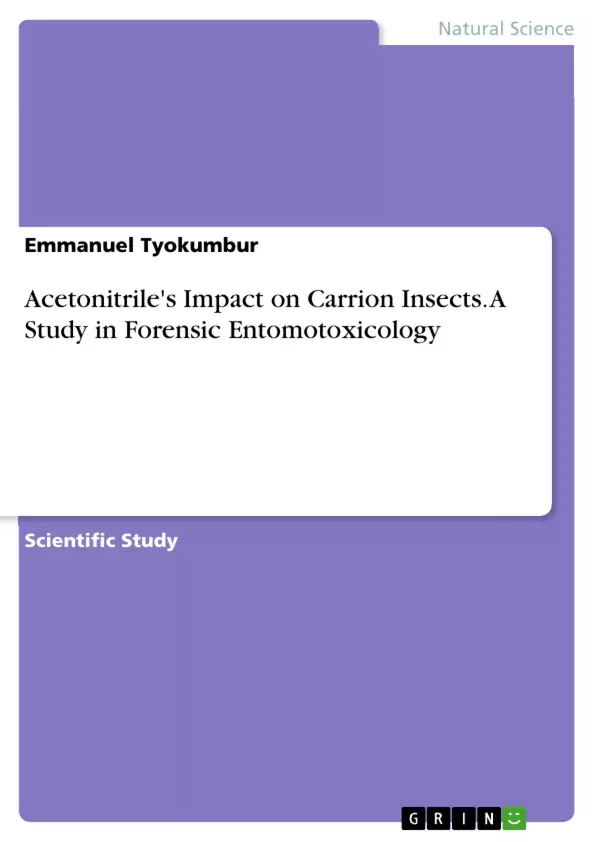The aim of this study is to articulate and highlight the research on the forensic entomotoxicological evaluation of carrion insects found on rabbits euthanized with acetonitrile. Key findings, methods, and conclusions are to be presented.
Two rabbits were used, one euthanized with acetonitrile and the other serving as a control experiment.
Inhaltsverzeichnis (Table of Contents)
- CHAPTER ONE
- 1.1. Definition and Concept of Entomotoxicology
- 1.2. Definition and Concept of Forensic Entomotoxicology.
- 1.3. Carrion Insects
- 1.4. Acetonitrile
- 1.5. Justification for the Study.
- 1.6. Aims and Objectives of the Study...
- CHAPTER TWO
- 2.2. Subdivisions of Forensic Entomology.
- 2.2.1. Medicolegal Forensic Entomology.
- 2.2.2. Urban Forensic Entomology.
- 2.2.3. Wildlife Forensic Entomology
- 2.2.4. Stored Product Forensic Entomology.
- 2.2.5. Forensic Acarology.
- 2.3. Applications of Forensic Entomology and Entomoxicology.
- 2.3.1. Estimation of Post-Mortem Interval (PMI).
- 2.3.2. Determination of Location of Death.
- 2.3.3. Determination of drug Administration or Abuse
- 2.4 Animal Decomposition..
- 2.5 Succession among Insects.
- 2.6 Historical Overview of Insect Succession Studies.......
- 2.7 Factors Affecting Carrion Insect Succession.
- 2.7.1. Location and Habitat.
- 2.7.2 Body size and Condition..
- 2.7.3. Temperature and Humidity
- 2.7.4 Drugs.……………
- 2.7.5 Presence of Scavengers .....
- 2.8 Carrion-Associated Insects and Arthropods....
- 2.8.1 Calliphoridae..........\li>
- 2.8.2 Sarcophagidae
- 2.8.3 Dermestidae
- 2.8.4 Cleridae.
- 2.8.5 Silphidae
- 2.8.6 Muscidae
- 2.8.7 Staphylinidae..
- 2.9 Acetonitrile
- 2.10 Review of Previous Studies
- CHAPTER THREE
- 3.1. Study Site............
- 3.2 Sample Collection and Processing.
- 3.3 Sampling for Insects
- 3.4 Sampling for Larvae
- 3.5 Sampling for Pupa
- 3.6 Measurement of Environmental Variables..
- 3.7 Measurement of Larval Body Length and Weight......
- 3.8 Sample Analyses..
- CHAPTER FOUR...
- 4.1 Abundance and Species Composition of Carrion Insects Found on the Rabbits' Carcasses.
- 4.2 Carrion Insect Succession on RB1 and RB2.......
- 4.4 Effect of Double Lethal Dose of Acetonitrile on the Length and Weight of Larva..
- 4.5 Variations in Environmental Variables at the Study Site........
- CHAPTER FIVE
- 5.1 Abundance and Species Composition of Carrion Insects on Rabbit Carcass
- 5.2 Carrion Insect Succession on Rabbit Carcasses.
- 5.3 Effect of Lethal Dose of Acetonirile on the Length and Weight of Larvae ....
- 5.4 Variations in Environmental Variables at the Site.
- 5.5 Conclusion and Recommendation
Zielsetzung und Themenschwerpunkte (Objectives and Key Themes)
This study investigates the impact of a double lethal dose of acetonitrile on carrion insect succession using euthanized rabbits as a model. The research aims to determine how the presence of acetonitrile affects the abundance and species composition of insects attracted to the carcasses, as well as the growth and development of the insect larvae. Key themes include:- Forensic entomology and the role of carrion insects in post-mortem investigations.
- The influence of toxic substances on carrion insect succession and larval development.
- The application of forensic entomology to determine the presence of toxins in a deceased individual.
- The importance of environmental factors in carrion insect succession.
- The potential of forensic entomology to provide valuable information in criminal investigations.
Zusammenfassung der Kapitel (Chapter Summaries)
Chapter One provides a comprehensive overview of the field of forensic entomology and its significance in criminal investigations. The chapter delves into the concepts of entomotoxicology, the role of carrion insects, and the characteristics of acetonitrile. Chapter Two explores the various subdivisions of forensic entomology, including medicolegal, urban, wildlife, and stored product entomology, as well as forensic acarology. The chapter highlights the applications of forensic entomology, including estimating the post-mortem interval, determining the location of death, and identifying the presence of drugs or other toxins. Furthermore, it examines animal decomposition, insect succession, and the factors influencing this process. Chapter Three details the methodology employed in the study, including the selection of the study site, sample collection procedures, and the measurement of environmental variables. Chapter Four presents the findings of the research, analyzing the abundance and species composition of carrion insects on the rabbit carcasses, examining the impact of acetonitrile on insect succession and larval development, and exploring the variations in environmental variables at the study site.
Schlüsselwörter (Keywords)
Forensic entomology, carrion insects, acetonitrile, post-mortem interval, insect succession, decomposition, environmental factors, toxicology, drug detection, criminal investigations.- Citar trabajo
- Emmanuel Tyokumbur (Autor), 2023, Acetonitrile's Impact on Carrion Insects. A Study in Forensic Entomotoxicology, Múnich, GRIN Verlag, https://www.grin.com/document/1378336



